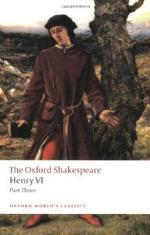|
This section contains 772 words (approx. 2 pages at 400 words per page) |

|
King Henry VI, Part 3 Summary & Study Guide Description
King Henry VI, Part 3 Summary & Study Guide includes comprehensive information and analysis to help you understand the book. This study guide contains the following sections:
This detailed literature summary also contains Further Study on King Henry VI, Part 3 by William Shakespeare.
Henry VI, Part Three begins with a debate between King Henry and York over which of them is the rightful king of England. The argument has its origins in the reign of Henry's grandfather, King Henry IV, a Lancastrian who came to power by usurping Richard II, grandson and direct heir of King Edward III. (Shakespeare's tetralogy of plays Richard II, Henry IV, Pan One and Two, and Henry V dramatizes the ascendancy of the Lancastrians.) York can prove that his family tree follows a more direct line to King Edward III's throne than Henry's does; consequently, York has the right to rule England, while Henry, whose grandfather became king by force, should simply be the duke of Lancaster. This contention between the supporters of York (Yorkistswhose emblem is the white rose) and the supporters of King Henry (Lancastrianswhose emblem is the red rose) is what the Wars of the Roses are all about. In I.i.134, Henry admits to himself that his title to the throne is weak. So in I.i. 194-200, he entails the crown to York and to his heirs "for ever," on condition that he be allowed to remain king during his lifetime, and that the Wars of the Roses be ended. York accepts this deal, declaring, "Now York and Lancaster are reconcil'd" (I.i.204).
Unfortunately, an end to the wars is not as simple as York and King Henry suggest. The contention began in Henry VI, Part One. The fighting has been long, bitter, and very bloody. Both Clifford and Northumberland, for example, lost fathers in the fight against the Yorkists in Henry VI, Part Two. In Henry VI, Part Three, "They seek revenge, and therefore will not yield" even though Henry and York announce that the conflict is over (I.i.190). Later, Clifford gets his revenge by brutally killing first York's young son Rutland and next York himself (I.iii and I.iv). The result is that York's remaining sons vow to avenge themselves on Clifford. When they find him already slain on the battlefield, they feed their rage by jeering at Clifford's dead body, chopping off his head, and putting it in place of their father's head on the gates of the town of Yorkthereby exacting "measure for measure" (II.vi.46-86).
Thus in Henry VI, Part Three, the fighting has gone well past its original purpose until what mat ters most is retribution (or, as Gloucester puts it after killing King Henry: "may such purple tears [of blood] be always shed / From those that wish the downfall of our house!" [V.vi.64-65]). To make matters worse, the two sides are evenly matched so that as Henry observes in II.v.1-13, neither side is "conqueror nor conquered," and the fighting drags on while Yorkists and Lancastrians take turns at winning or losing, and while fathers inadvertently kill their sons, and sons accidentally kill their fathers after they are drafted into the fighting on opposite sides.
This chaotic legacy of civil war is familiar to audiences today in, for example, the aftermath of fighting between the Hutus and Tutsis of east Cen tral Africa and between the Serbs, Croats, and Bosnians of the former Yugoslavia. In both modern conflicts, innocent people have been brutalized, neighbors have betrayed neighbors, and the original political and ethnic reasons for the wars have been overshadowed by mass suffering as well as by the bitter, personal need for retribution and reparation which seems impossible to satisfy.
Another element contributing to the acrimony of the Wars of the Roses is that it is essentially a family feud. King Henry and York are distant relatives, as are many of the noblemen arrayed on either side. Toward the end of the play, as the seemingly endless war turns increasingly chaotic, the feuding also occurs within each camp. In IV.i, for example, George, the duke of Clarence, becomes outraged when his brother, the newly crowned Yorkist King Edward, imprudently marries Lady Grey; Clarence is further incensed when Edward gives special treatment to his new wife's relatives at the expense of his own brothers. In retaliation, Clarence joins the Lancastrians. (His defection is temporary, lasting only until V.i.81," but it comes back to haunt him later when his wicked and ambitious brother Gloucester uses this early disloyalty against him in Shakespeare's sequel, Richard III.) Today, most family feuds do not precipitate warfare; however, they can result in violence, and they frequently stretch over generations, engulfing grandparents, cousins, and siblings in resentment long after the original argument is forgotten, making family gatherings impossible or, at best, unpleasant.
Read more from the Study Guide
|
This section contains 772 words (approx. 2 pages at 400 words per page) |

|



